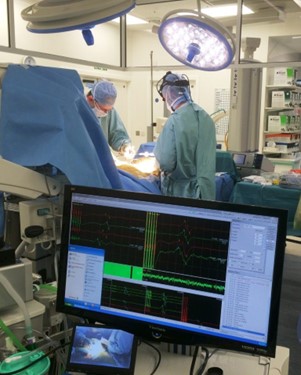What we do in spinal monitoring
In some cases patients with scoliosis or other spinal deformities may need an operation to straighten their spine.
The surgeons will fit metal rods to hold the spinal column in the correct place until the bone graft fuses to make the correction permanent.
The spinal cord can be injured during this process without the surgeon ever knowing. The risk may be very small but the consequences can be very serious, so the surgeons need regular checks throughout the operation for any evidence of injury to the spinal cord.
We work for the spinal surgery team, performing these checks throughout the operation to reduce the chance of permanent spinal cord injury.
Although no test can be 100% reliable, directly testing the neural pathways through the spinal cord is accepted as the best way of finding an injury.

How does it work
Electrical signals can be generated in nerves in the legs and detected when they reach the brain using electrodes on the head, or as they pass through the spinal cord at the neck. Similarly, signals can be generated in the brain that travel down to the legs and can be detected using electrodes over the leg muscles.
Where possible, we prefer to do both and regularly check that the signals can pass up and down the spinal cord all through the operation.
Specially trained clinical scientists monitor these signals as part of a care team with the anaesthetists and the surgeons themselves. Unexpected changes to the signals are immediately investigated by the whole team to ensure that any significant changes are reversed as quickly as possible.
Tests we carry out
We use the following tests to monitor the spinal cord during surgery:
- Transcranial motor evoked potentials.
- Somatosensory evoked potentials (recorded from the spinal canal and the scalp).
Contact us
James Blake, service lead: 0191 2823814
Spinal monitoring service, Medical Physics
Level 2, Leazes Wing Royal Victoria Infirmary, Newcastle upon Tyne, NE7 7DN.